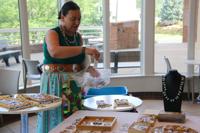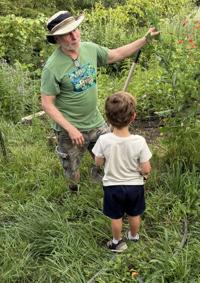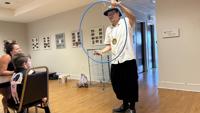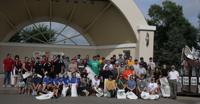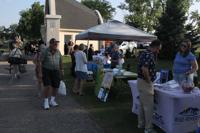RiverFest, a multi-day event in Hudson, celebrates Native American culture and the natural world, while informing attendees about the dire need to preserve the cultural and environmental foundations of their community.
Evy Nerbonne, who coordinates the Native American celebration that capped off the event Saturday, said that educating residents to protect, understand and appreciate the resources they have around them is crucial — “The St. Croix River and Hudson were once native lands.” As was the whole United States.
History and art intertwined
Melissa “Niigaaniigaabowikwe” Fowler, who sold birch and bead jewelry while speaking to curious customers at the Phipps Center for the Arts on Saturday, said the practice surprisingly came naturally to her when she started making intricate designs from birchbark in 2011.
She had an artist’s background in painting and pottery, but, for her, birchbark as an art form was different because it centered a connection to land. She uses a lot of Indigenous plants and flowers, many with pre-colonial provenance.
She also encompasses trade beads — antiques that traded hands across continents — some of which were made centuries ago, accounting for historical accuracy when creating her work.
And in using material gathered from the natural world to sell jewelry, she joined a long-held tradition in Native American culture. To provide for their families, Native American artists would forage to make jewelry as well as other arts and crafts, which they sold at trade hubs across the continent.
“These are not my patterns. These are for everyone,” Fowler said of the wearable art pieces she made. “I’m hoping to inspire other people to do this kind of work, because I don’t want to be the only birchbark artist out there. Sometimes, in certain communities, in certain tribes, there’s less of it.”
Fowler quit her full-time job to start Creatively Indigenous Jewelry and Art with her husband, Thomas “Ogimaawajiweb” Fowler, in 2018.
She took up the craft after reorienting herself with the culture her family was removed from. The government relocated Melissa’s family away from the Lac Courte Oreilles Tribe — one of six bands of the Lake Superior Chippewa — as part of one of many programs to force Native Americans off reservations and into urban areas to assimilate with white America.
Eventually she reconnected. Going through Ancestry.com, she found census records that gave her insights into past generations of her family. She grew interested in birchbark art when her eldest child went through Native American ceremonies. For her husband, Thomas, that marked a return to ceremonies. For Melissa, it marked a first. She had never been through ceremonies as a kid, growing up away from her family’s reservation.

Melissa “Niigaaniigaabowikwe” Fowler on Saturday. Photo: Jack White/Star-Observer.
For those who are interested in learning about her culture, Melissa said that events like RiverFest are an excellent opportunity, one that isn’t always presented in mainstream society.
“We’re still out here practicing our ways and learning the things that we did, even though we don’t necessarily live in teepees and wigwams like we used to, we’re still very much here. And we have a beautiful culture,” she said.
A walk, a sight and a taste of nature
The hot sun pounded onto a yard full of free-spirited plants at Bluebird Hill, a learning center and homestead north of Hudson.
Forager Russ Lake, a Hudson resident, zigzags along its garden paths, plucking leaves and buds to share with less-experienced foragers on his plant walk through owner Heidi Madsen’s Bluebird Hill Homestead.
As Lake pointed out, “Wild plants, in general, are higher in nutrition than their cultivated cousins.” His unspoken message, made clear from the event’s proceedings? Bon appétit.
From familiar mint and basil to Sweet Annie — a plant that Lake said was studied as a treatment for COVID-19 — to spicy horseweed, the homestead in Hudson offered tastes as well as sights to give attendees a sense of the natural world during RiverFest. But not all plants are safe.
“There aren’t many toxic plants here, but the ones we [do] have are really toxic. Water hemlock is really toxic,” Lake said.
He emphasizes that it’s important to identify plants accurately. He offered up advice, using two or three good reference books. Apps are not as reliable, he said. Among the authors he recommends: Samuel Thayer, a self-taught forager from northern Wisconsin. “He’s nationally known for foraging. He’s a huge inspiration,” Lake said.
Other tips Lake gave are about inexpensive, easy-to-assemble accessories to make foraging easier. His collection includes small pouches, grocery bags, plastic jugs trimmed and fitted with a clasp to attach to a forager’s belt, a simple digging tool and a berry hook which resembles a 7 shape.
Although he added, “I’ve always been interested in camping, plants, things wild,” his plant walks didn’t really begin until the pandemic. That’s when Jacki Bradham from the St. Croix Riverfest group asked him to do a virtual tour of edible plants in the community.

Russ Lake at the garden walk Friday.
“I said, ‘Sure,’ we did it in my backyard.” He now conducts about four plant walks a year, allowing him to share nature and its connections. “I don’t do them for money.”
Lake considers foraging an all-season activity, but he does most of his work during the spring, craving then finding succulent sprouts and buds. He adds that as plants age, they become more fibrous and tougher.
Responses from this group’s budding foragers seem to acknowledge Lake’s influence as they walk, listen, question and nibble. A voice in the group talks about looking at “the weeds” in her pasture with new eyes.
Sparked by childhood searches for morel mushrooms, Ben Wallace, a participant from Hudson, recalls growing up near woods in Lakeville, Minn., and foraging with his father and sisters in the Prior Lake, Minn., area. On this summer’s day at Bluebird Hill, he and his wife are keeping that tradition. They have brought their almost-4-year-old son who has been taught to spot safe, edible berries on plant walks, by putting into practice Russ Lake’s words, “Be a responsible forager. Give back to the land.”
More information about Lake’s plant walks is available on Facebook at Western Wisconsin Foragers and Weed Wackers. Madsen says Bluebird Hill focuses on “classes for kids to build their connection with nature.” Details are at https://bluebirdhillhomestead.com
Michael ‘Laughing Fox’ Charette and the art of catching dreams
Storyteller and artist Michael “Laughing Fox” Charette hosted a dream catcher class on Saturday as part of this year’s RiverFest celebration.
Charette’s a musician, writer and performer and a member of the Red Cliff Band of Lake Superior Chippewa (Ojibwe). As participants made their way to the Phipps Center for the Arts’ River Room, Charette and supplies like wax string, beads and wooden hoops welcomed them.
Charrette demonstrated the process, starting with a double knot on a hoop, then creating loops by going over, under, and through the hoop. The technique involves tying half knots and maintaining consistent spacing. Charrette guided participants through the steps, including the importance of the design’s thickness and the creation story of the dream catcher.
The session included hands-on instruction, troubleshooting, and final touches like adding a bead to symbolize the guardian spirit.
“Traditionally, for the dream catchers, you’re supposed to hang them above your bed, and it catches the bad dreams in there. And then, when the sun comes up the next day, all those bad dreams perish in the life of a new day,” said Charette.
The class also highlighted the story behind it, involving a grandmother spider teaching a grandmother how to make the dream catcher.
“And thus, the bead represents the guardian spirit, the grandmother spider, who taught the grandmother how to make the [dream catcher]. The grandmother would see that her granddaughter was having a bunch of nightmares, and she wanted to help her,” he said. “One day, she watched a spider making a web, and she saw how the web would catch flies and insects. Later, when the grandmother went to sleep, the spider visited her dreams and said, “I know how you feel and I want to help you.” So she would teach her how to make this spider’s web that would catch the bad dreams. It’s a story about unconditional love.”

Storyteller Michael “Laughing Fox” Charette teaching RiverFest attendees how to make a dreamcatcher on Saturday, July 26. Kaitlyn Doolittle/Star-Observer.
As participants were wrapping up, one reflected on their time with the class.
“It was unique, it was still fun,” said attendee Cathryn Hamilton. “I like to learn the stories. It’s good hearing the stories. I like to know the history of those things.”
Later that day, Charette performed in the RiverFest Native American Celebration with storytelling and flute music.
Cleaning the St. Croix River: a group effort
About 60 volunteers showed up Tuesday morning to make the riverfront glow. With gloves and bags secured, volunteers were ready to roll up their sleeves.
“We just wanted to help the community clean up the park a little. Getting rid of litter is important,” said volunteer Luke Carr. “[Parks are] public spaces for everyone to share and enjoy, so making them clean is important.”

The group of volunteers at this year’s RiverFest river cleanup on Tuesday, July 22. Volunteers collected trash throughout Hudson and North Hudson. Kaitlyn Doolittle/Star-Observer.
The cleanup locations included North Hudson’s Ferry Landing Park, Brown’s Beach and Lake Mallalieu and Hudson’s Lakefront Park Walking Trail, Dike Road, Lakefront Park, Coulee Road and King’s Boat Landing.
After their hard work, some of the trash collected went towards Scrappy’s new “skin.” Scrappy is a large, metal fish sculpture decorated annually at the Phipps Center for the Arts during the remainder of the week. Volunteers use the trash collected today to give this RiverFest mascot a makeover.
Before people got to work, RiverFest volunteer Clarence “Buck” Malick reminded everyone to enjoy the scenes and sounds of the river while being in nature.
“When you’re picking the trash out there, you’re going to be able to hear the river movement. You’re going to be able to see it. Take advantage of that,” he said.
In the early afternoon, volunteers were thanked for their work with a complimentary lunch and an animal presentation by the St. Croix Valley Carpenter Nature Center.
Booths on full display
The RiverFest partner display booths were up and out on Thursday at Lakefront Park. RiverFest partner organizations and other non-profits groups held booths with information, activities and demonstrations before and during the St. Croix Valley Community Band concert.
Some of the other booths present included the Hudson Chamber of Commerce, Hudson Hot Air Affair, Hudson Grocery Co-Op, Wisconsin Conservation Voters and the Wild Rivers Conservancy.
Wild Rivers Conservancy, formerly the St Croix River Association, supports the St. Croix River and is the official nonprofit partner from the Saint Croix National Scenic Riverway which is a unit of the National Park Service.
Wendy Tremblay, the community engagement manager with Wild Rivers Conservancy, finds that events like RiverFest are needed to keep that culture of environmental care alive within the community.
“I think one of my favorite parts [of RiverFest] is the volunteer aspect. Every Tuesday during RiverFest, they have the volunteer program, and then [volunteers] create Scrappy, the sculpture. Everybody loves Scrappy. It’s just a really great visual of why we want to keep the river clean, and what happens if we don’t.” she said. “ I think [events like RiverFest] are all just really great community builders and help with that awareness of the national park in our backyard.”

RiverFest attendees stroll throughout LakeFront park to learn more about the RiverFest partner booths on Thursday, July 24. Kaitlyn Doolittle/Star-Observer.
Earlier, the Star-Observer also covered the Minnesota, Wisconsin DNR discussion of invasive carp.




